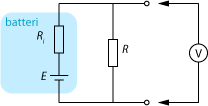Processing Math: Done
Lösning 4.2:3
FörberedandeFysik
(Skillnad mellan versioner)
(Ny sida: Kirchhoffs lag ger <math>E-R_i \cdot I–U = 0</math> och Ohms lag <math>I=U/R</math> ger med insatta värden<br\> <math>E-R_i \cdot 4,0/0,8–4,0 = 0</math><br\> <math>E-R_i \cdot 3,0/0,...) |
|||
| Rad 3: | Rad 3: | ||
<math>E-R_i \cdot 4,0/0,8–4,0 = 0</math><br\> | <math>E-R_i \cdot 4,0/0,8–4,0 = 0</math><br\> | ||
<math>E-R_i \cdot 3,0/0,2–3,0 = 0 </math><br\> | <math>E-R_i \cdot 3,0/0,2–3,0 = 0 </math><br\> | ||
| - | <math>E = 4,5 V</math><br\> | + | <math>E = 4,5 \,\mathrm{V}</math><br\> |
<math>R_i = 0,1\Omega </math><br\> | <math>R_i = 0,1\Omega </math><br\> | ||
| - | <math>I= | + | <math>I=5 \,\mathrm{A}</math> vid <math>0,8\Omega</math><br\> |
| - | <math>I= | + | <math>I=15 \,\mathrm{A}</math> vid <math>0,2 \Omega</math><br\> |
[[Bild:losning_4_2_3.gif|center]] | [[Bild:losning_4_2_3.gif|center]] | ||
Nuvarande version
Kirchhoffs lag ger  I–U=0
I–U=0 R
R
 4
4 0
0 0
0 8–4
8–4 0=0
0=0
 3
3 0
0 0
0 2–3
2–3 0=0
0=0
 5V
5V
 1
1
 8
8
 2
2

